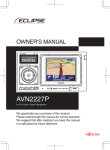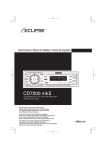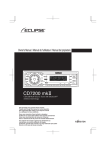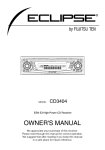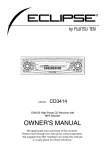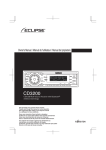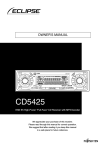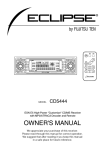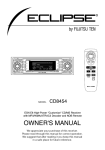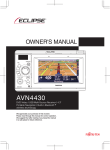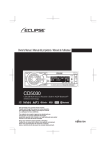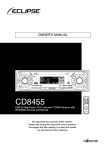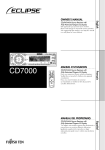Download Eclipse - Fujitsu Ten AVN 30D Car Stereo System User Manual
Transcript
For your safety in using the CD1200 For your safety in using the CD1200 Introduction Warnings and caution signs, illustrated below, are posted throughout this manual as well as on the CD1200. They show safe and correct ways to handle the product so as to prevent personal injury to you, others and to avoid property damage. Before reading through the manual, take time to read through and learn the important information listed in this section. Warning This “Warning” sign indicates a situation in which incorrect handling or disregard of this sign might result in death or serious personal injury. Caution This “Caution” sign indicates a situation in which incorrect handling or disregard of this sign might result in personal injury or may result solely in damage to property. Please read all materials such as manuals and warranties that have come with the product. Eclipse will not be held liable for unsatisfactory product performance due to failure to follow these instructions. 12 WARNING ● Do not modify this system for use other than that specified herein. Also, do not deviate from the installation procedures described herein; ECLIPSE will not be held liable for damages including, but not limited to serious injury, death or property damage resulting from installations that enable unintended operation. ● This main unit requires 12V DC and should only be installed in a vehicle with a 12V negative ground electrical system. Any other installation may cause a fire or other severe damage to the main unit and the vehicle. ● Never install this main unit where it will interfere with safe operation of the vehicle. Never block the drivers' view. Do not install main unit where it may interfere with operation of the brakes, the steering or any safety equipment, including seat belts and air bags. ● Before drilling holes in a vehicle for installation, you must confirm the locations of pipes, tanks, electrical wiring, and other vehicle systems and components to ensure that there will be no interference or contact. In addition, you must also apply rust prevention and leak prevention measures at the drilling area. Otherwise, fire or electric shock could occur. ● When installing main unit do not remove or alter existing vehicle fasteners, including nuts, bolts, screws, clips, and fittings. Never detach, move or alter existing vehicle wiring, including electrical grounds and straps. Alteration of existing vehicle components may make vehicle unsafe to operate. ● Before installation, remove the negative (-) battery terminal to prevent shocks, electrical arcing, fires, and damage to vehicle wiring and the main unit you are installing. ● Secure wiring with tape or plastic ties so that wires do not interfere with vehicle operation, including brake pedal, gear shifter and steering. Position wires so that they will not be rubbed, abraded, or damaged by moving vehicle components, including power seats. ● To avoid main unit and vehicle damage, including fire, never supply power to the installed main unit in a way which will overload the capacity of an existing vehicle circuit. Never leave a power supply wire or connection uninsulated. Always install supplied fuses, circuit breakers, and relays. 2 For your safety in using the CD1200 12 WARNING ● Air bags are vital safety equipment. Never install the main unit in a way which will alter air bag wiring or interfere with air bag deployment. Air bags must function properly in the event of an accident. I ● When installation is complete, test all vehicle electrical systems for proper operation, including lights, horn, brake lights, and emergency flashers. ● For your protection, never use a power drill without safety glasses or goggles. Debris or broken drill bits may cause severe eye injuries, including blindness. ● Use electrical tape to insulate the ends of all wires, even if not used. Proper insulation prevents arcs, shocks and fires. ● Some equipment or devices require the use of batteries. Never install or place this type of equipment where young children can get access to batteries. If a battery is swallowed, seek medical attention immediately. ● When vehicle is moving, never take your eyes off the road to make adjustments to the main unit. You must pay attention to the road to avoid accidents. Do not let the operation or adjustment of the main unit distract you from proper vehicle operation. ● The driver should not look at the screen while driving. Accidents may result if you are not paying attention to the forward direction. ● Do not put foreign objects in the loading slot of disc or USB input terminal. Fires or shocks may result. ● Do not disassemble or alter this main unit. Accidents, fires or shocks may result. ● Do not let water or foreign objects enter the internal parts of this main unit. Smoke, fires or shocks may result. ● Pay attention to where the remote control is left. Traffic accidents or problems with driving may result if the remote control makes its way under the foot pedals etc. when the vehicle is in motion. ● Do not use when abnormal operation occurs (the screen is not lit or no sound comes out). Accidents, fires or shocks may result. ● Always replace fuses with fuses of identical capacity and characteristics. Never use a high capacity fuse than the original. Using incorrect fuse specifications may cause a fire or severe damage. ● If foreign objects or water enters the main unit, smoke comes out, or there is a strange odor, stop using it immediately, and contact your dealer. Accidents, fires, or shocks may result if you continue to use it in these conditions. ● The driver should not change the CD or USB memory while driving. As accidents may result if you are not paying attention to the forward direction, first stop the vehicle at a safe location and then proceed. ● Plastic bags and wrappings may cause suffocation and death. Keep away from babies and children. Never put bag over your head or mouth. 3 For your safety in using the CD1200 12 CAUTION ● Wiring and installing this main unit requires expertise and experience. Professional installation is recommended. Consult with your dealer or a professional installer. Incorrect wiring may damage the main unit or interfere with safe vehicle operation. ● Use only the accessory parts as specified. Using other parts may cause damage to the main unit or cause parts to dislodge and/or detach unexpectedly. ● Do not install the main unit in places where it may get dew condensation on (around the air conditioning hose, etc.), come in contact with water, or in condition of high moisture, dust or oily smoke. If water, moisture, dust or oily smoke enters this main unit, smoke, fires or malfunctions may result. ● Avoid installing in places where it cannot be fastened securely or where there are strong vibrations. Also, if you installed the main unit with double-sided tape, first wipe away dirt and wax from the installation area. Otherwise, the main unit may come loose due to vibration while driving, causing problems for driving and resulting in traffic accidents or injuries. ● Do not install in places with direct sunlight or where it will be hit directly by hot air from the heater. This may increase the temperature of the interior of this main unit, resulting in fires and malfunctions. ● Do not obstruct the air flow of the heat sink or vents of this main unit. When the air flow of the heat sink or vents are obstructed, the interior overheats, and fires may result. ● Connect as specified in the installation manual. If not connected normally, fires or accidents may result. ● When installing in vehicles equipped with air bags, check the manufacturer's cautions regarding operation to ensure proper operation of the airbags. ● Install wiring in a manner that will not allow them to be pinched by moving parts, damaged by screws, or damaged by metal parts. Accidents, fires and shocks may result from disconnection and electrical shorts. ● Avoid hot surfaces when wiring main unit. High temperatures may damage wiring, causing shorts, arcing and fires. ● When changing the installation location for this main unit, please consult the dealer where you bought it for safety reasons. Expertise is necessary for removal and installation. ● Keep volume to a reasonable level so that you can hear sounds from outside the vehicle, including warning sounds, voices, and sirens. Failure to do so may cause an accident. ● When an external amplifier is connected, the guide tone will not sound. ● Do not put your hands or fingers into the loading slot of disc or USB input terminal. Injuries may result. ● Do not touch the heat dissipating part of the amp. Burns may result from the heat of this part. ● Do not recharge dry batteries. Dry batteries may rupture, resulting in injuries. ● Do not use batteries other than those specified. Also, do not mix old and new batteries. Injuries or pollution to the surroundings may result from battery ruptures and leakage. 4 For your safety in using the CD1200 12 CAUTION ● When inserting batteries into the remote control, be careful with the polarity (positive/ negative), and insert them as indicated. If the battery polarities are incorrect, injuries and pollution to the surroundings may result from battery ruptures and leakage. I ● Replace used batteries as soon as possible; they may leak and damage the remote control. Battery leakage can burn your skin or your eyes. Wash hands after handling. ● If alkaline solution from alkaline dry batteries makes contact with your skin or clothes, flush with clean water. If any of the solution gets in your eyes, also flush clean with water and then seek medical attention. ● Do not short, disassemble or heat the batteries, or place them in fire or water. Fire and injuries may result from battery rupture and leakage. ● Store the remote control in a place away from direct sunlight, high temperatures, and high moisture levels. The outer case may change shape, and the batteries may rupture and leak. ● Do not use this main unit except for in-vehicle use. Shocks or injuries may result. ● Be careful of the position of the volume when turning the power source ON. Hearing damage may result if very loud noise is emitted when the power is turned ON. ● Do not operate under abnormal conditions such as when the sound is broken or distorted. Fires may result. ● This main unit uses invisible laser light. Do not disassemble or alter this main unit. If trouble occurs, contact the dealer where you bought the main unit.Altering this main unit may cause exposure to laser emissions (worsening eyesight), or result in accidents, fires or shocks. ● If the main unit is dropped or the cosmetics appear broken, turn off the power to the main unit and contact your dealer. If used in this condition, fires or shocks may result. 5 6 Table of Contents For your safety in using the CD1200 ........................................... 2 I Operating precautions ................................................................ 12 II Names of controls and parts ..................................................... 13 III How to operate the CD/MP3/WMA/AAC player ......................... 16 IV How to operate the USB music file player ................................ 26 V How to operate the tuner ............................................................ 31 VI How to use the optional remote control ................................... 34 VII How to operate the AUDIO CONTROL ...................................... 36 VIII Making changes with Function Mode ....................................... 38 IX How to operate the main unit with an optional Direct Cable for iPod ...................... 40 X Others .......................................................................................... 44 XI If you have a question: ............................................................... 45 XII Specifications .............................................................................. 48 XIII How to contact customer service .............................................. 50 XIV 7 Table of Contents For your safety in using the CD1200.................................................... 2 Operating precautions......................................................................... 12 Notes on operation ....................................................................................................... 12 Names of controls and parts............................................................... 13 Turning the power on and off........................................................................................ 14 Switching Audio Modes ................................................................................................ 14 Adjusting volume .......................................................................................................... 14 Setting time (Clock Adjust) ........................................................................................... 14 Detaching the front panel ............................................................................................. 15 Using the detachable panel.................................................................................... 15 How to remove the detachable panel..................................................................... 15 How to attach the detachable panel....................................................................... 15 How to operate the CD/MP3/WMA/AAC player.................................. 16 About compact discs .................................................................................................... 16 About brand new CDs ............................................................................................ 16 About CD accessories............................................................................................ 17 About borrowed CDs .............................................................................................. 17 How to remove CDs ............................................................................................... 17 About irregularly-shaped CDs ................................................................................ 17 About cleaning a CD..................................................................................................... 17 About MP3/WMA/AAC.................................................................................................. 18 What is MP3/WMA/AAC?....................................................................................... 18 Playable MP3 file standards................................................................................... 18 Playable WMA file standards ................................................................................. 18 Playable AAC file standards................................................................................... 19 ID3/WMA tag .......................................................................................................... 19 Media ..................................................................................................................... 19 Format of discs....................................................................................................... 20 File names.............................................................................................................. 20 Multi-sessions ........................................................................................................ 21 Precautions during MP3/WMA/AAC playback ....................................................... 21 MP3/WMA/AAC playing time display ..................................................................... 21 Display order of MP3/WMA/AAC file/folder names ................................................ 21 Listening to CD ............................................................................................................. 22 TRACK (FILE) UP/DOWN ............................................................................................ 22 Skip forward and backward by 10 files ......................................................................... 22 FAST FORWARD/REWIND ......................................................................................... 22 SCAN/REPEAT/RANDOM ........................................................................................... 23 Searching for a music file ............................................................................................. 24 FOLDER REPEAT/RANDOM....................................................................................... 25 DISPLAYING TITLE ..................................................................................................... 25 Ejecting the disc ........................................................................................................... 25 8 Table of Contents How to operate the USB music file player ......................................... 26 About playable USB memory standards....................................................................... 26 Playable MP3 file standards................................................................................... 26 Playable WMA file standards ................................................................................. 26 Playable AAC file standards................................................................................... 26 Format of USB memory ......................................................................................... 27 How to operate the USB music file player .................................................................... 28 Listening to music files in USB memory ................................................................. 29 Searching for a music file ....................................................................................... 29 Disconnecting USB memory......................................................................................... 30 How to operate the tuner..................................................................... 31 Listening to the tuner .................................................................................................... 31 Tuning to a station ........................................................................................................ 31 Automatically storing stations into memory (The automatic preset mode: ASM) ......... 32 Manually storing stations into memory ......................................................................... 32 Changing the reception sensitivity................................................................................ 33 Changing the radio band location................................................................................. 33 How to use the optional remote control ............................................ 34 Precautions in use of the remote control ...................................................................... 34 Cleaning the remote control ......................................................................................... 34 Replacing the battery.................................................................................................... 35 How to operate the AUDIO CONTROL ............................................... 36 Switching audio control modes ..................................................................................... 36 Making changes with Function Mode ................................................ 38 Switching the Function Mode ....................................................................................... 38 Making changes with Equalizer Mode .......................................................................... 38 Setting guide tone (Guide Tone) .................................................................................. 38 Switching demonstration screen display (Demo) ......................................................... 38 Changing illumination color .......................................................................................... 39 How to operate the main unit with an optional Direct Cable for iPod ................................................................................................. 40 Listening to iPod music files (If an iPod is not connected) ........................................... 40 Listening to iPod music files (If an iPod is connected) ................................................. 40 Advancing to the next music file or returning to the beginning of the music file being played ........................................................................................................................... 41 Fast Forward/Rewind ................................................................................................... 41 Searching for a music file ............................................................................................. 41 Repeating the same music file (REPEAT).................................................................... 42 Playing music files in random order (SHUFFLE) .......................................................... 42 Displaying text .............................................................................................................. 42 9 Table of Contents Others.................................................................................................... 44 Connecting portable audio players to the AUX jack ..................................................... 44 Switching the AUX mode on and off ...................................................................... 44 If you have a question: ........................................................................ 45 Displayed information (for troubleshooting) .................................................................. 45 Specifications....................................................................................... 48 How to contact customer service....................................................... 50 10 11 Operating precautions Operating precautions Introduction <Your CD1200 will perform well over a long period of time through correct handling and care.> Notes on operation • For your safety, play only at volume levels that allow outside sounds to be heard. • Discs with the logo shown to the left can be played. • You can play music CDs (CD-R/CD-RW) on this player. Be sure to use discs that have been properly processed. Depending on the editing format and software used, some discs may not play properly. TEXT • Do not insert anything other than a CD into the main unit. Do not insert any foreign objects, such as coins or credit cards, into the disc slot. • Avoid severe mechanical shock. When the player is subjected to severe vibration while traveling over a rough surface, playback may be intermittent. When a situation like this occurs, resume playback after returning to a smoother road. • About dew condensation. In cold or rainy weather, just as the interior glass surface gets fogged, dew (water condensation) may also settle on the main unit. When this occurs, disc playback may become intermittent or impossible. Dehumidify the air in the vehicle for a while before resuming playback. • Cleaning the disc slot. The disc slot tends to get dusty. Clean it occasionally to prevent accumulated dust from scratching the discs. * Commercially available cleaning discs may not be used with this main unit. 12 Names of controls and parts Names of controls and parts Introduction Front view II III No. a Button Name/Function No. Activates and deactivates mute. Audio mode : [SOURCE] button h Switches audio mode. Selects radio preset channels and performs disc mode functions. Adjusts volume. [SELECT] button d Recalls and switches the audio control modes. [TRACK/SEEK] button i [FUNCTION] button e f g Switches to function mode. Selects radio station and CD tracks. [DISP] button j Disc slot Switches the display details. [Detach] button Inserts compact discs. [e] button Carries out SCAN, REPEAT and RANDOM playback of tracks (files) and skips back or forth by 10 tracks (files). Tuner mode : [VOL] button c Name/Function Buttons [1] to [6] Turns deck power ON/ OFF. b Button [MUTE/PWR] button k Ejects CD. Detach the left end of the front panel from the body of the main unit. [BAND/ASM] button l Switches radio band, ASM action. Recalls and switches the search mode. 13 Introduction Turning the power on and off When the power is turned on, the state used when the power was turned off such as CD and tuner playback is restored. 1 Turn to the right: Increases the volume. Turn to the left: Decreases the volume. ATTENTION ATTENTION When power is ON, press and hold the [MUTE/PWR] button until you hear a beep. Switching Audio Modes Press the [SOURCE] button. Press the button to switch modes in the following sequence: FM/AM → CD (MP3/WMA/AAC) → *2 USB*1→iPod*1→ AUX*3 → FM/AM www *1: Cannot be selected if the corresponding device is not connected to the main unit. *2: Not displayed if no disc is inserted. *3: Cannot be selected if the AUX mode is not set to ON. For details, refer to "Switching the AUX mode on and off" on page 44. 14 Turn the [VOL] button. The power will come ON. The power will go OFF and the main unit will be in Standby. 1 1 When power is OFF, press the [MUTE/PWR] button. When the main unit's power is turned on for the first time or if the battery terminals have been disconnected because of a reason such as vehicle maintenance and the power is then turned back on, the main unit will start up in FM1 mode. After this, the broadcast stations will be searched for automatically and stored in buttons [1] to [6]. 2 Adjusting volume Press the [MUTE/PWR] button for less than one second to cut the volume or restore it instantly. 12 CAUTION Do not adjust the volume or other controls while driving the vehicle. Do so only while parked in a safe location. Setting time (Clock Adjust) This main unit uses the 12-hour display notation. 1 Check that the main unit is in standby (When the clock is displayed). 2 Press and hold the [DISP] button. When the clock display is flashing. 3 Turn the [VOL] button to adjust the time. Right: The minutes will advance. Left: The hours will advance. 4 Press the [DISP] button briefly. Names of controls and parts Detaching the front panel Using the detachable panel The front panel of the main unit can be removed. By removing this panel when you leave the vehicle, you can prevent the theft of the main unit. How to attach the detachable panel 1 Insert the right end of the front panel into the main unit. III Engage the catch at the right end of the front panel with the lock on the main unit itself. How to remove the detachable panel 2 1 Press the [Detach] button. The left end of the front panel detaches from the body of the main unit. 2 Insert the front panel. Press the left end of the front panel until it clicks into place. Remove the front panel. Hold the front panel and pull it toward you to remove it. 12 CAUTION • If you drop the detachable panel or subject it to impact, it may be damaged or malfunction. • Do not attempt to detach or attach the detachable panel while driving since this could cause an accident. 3 Put the front panel into the case. • Store the detachable panel at a location free from humidity, dust, and water. Push to open the front panel case and put the front panel in it. • Do not leave the detachable panel in locations that are likely to become hot, like the dashboard and surroundings. 15 Operation How to operate the CD/MP3/WMA/AAC player Operation About compact discs • The signal recorded on a compact disc is read by a laser beam, so nothing touches the disc surface. A scratch on the recorded surface or a badly warped disc may cause deteriorated sound quality or intermittent playback. Observe the following precautions to ensure high quality sound performance: • Do not leave an ejected disc in the disc slot for very long; the disc may warp. Discs should be stored in their cases and kept away from high temperature and humidity. • Do not adhere of paper or tape. Do not write on or scratch either side of a disc. • Discs spin at a high speed inside the main unit. Keep cracked or warped discs out of the player to avoid damaging the main unit. • Avoid touching the recorded surface when handling a disc; handle discs by their edges. About brand new CDs Rough Edges Ballpoint pen Rough Edges Flakes Recorded surface 16 • You may notice that some brand new discs are rough around the center hole or outside edge. Remove the rough edges with the side of a ballpoint pen, etc. Rough edges may prevent proper loading in the main unit. Flakes from the rough edges may also stick to the recorded surface and interfere with playback. How to operate the CD/MP3/WMA/AAC player About CD accessories • Do not use accessories (stabilizers, protective seals, laser lens cleaners, etc.) sold for “improving sound performance” or “protecting CDs.” The changes in CD thickness or outside dimensions made by these accessories may cause problems in the player. • Please be sure NOT to attach any ring-shape protector (or other accessory) to your discs. Those protectors are commercially available and said to protect disc and to improve sound quality (and antivibration effect), but they can do more harm than good in regular uses. The most common problems are disc insertion, disc ejections, and won't play problems due to the protector ring that came off in the disc mechanism. About borrowed CDs • Do not use a CD with glue or remnants of adhesive tape or labels. They may cause the CD to get stuck inside or damage the main unit. How to remove CDs OKAY • When removing the ejected disc, pull it straight out along the slot. Removing the disc in a downward or upward angle may scratch the recorded surface of the disc. O N D O O G About irregularly-shaped CDs • Specially-shaped CDs, like heart-shaped or octagonal CDs, cannot be played. Do not attempt to play them, even with an adapter, since they may damage the player. About cleaning a CD • Use a commercially available compact disc cleaner to clean a CD, wiping gently from the center to the edge. 17 IV Operation XXXX XXXX XXXX • Do not use benzine, thinner, LP record spray or other cleaners on CDs. They may damage a CD' s finish. About MP3/WMA/AAC ATTENTION The making of MP3/WMA/AAC files by recording from sources such as broadcasts, records, recordings, videos and live performances without permission from the copyright holder for uses other than personal enjoyment is prohibited. What is MP3/WMA/AAC? MP3 (MPEG Audio Layer III) is a standard format for audio compression technology. By using MP3 a file can be compressed to one-tenth the size of the original. WMA (Windows MediaTM Audio) and AAC (Advanced Audio Coding) are formats for audio compression technology. WMA files can be compressed to a size smaller than MP3 files. AAC is said to have a high rate of compression which is about 1.4 times that for MP3 files with the same audio quality. This main unit has limitations on MP3/WMA/AAC file standards and recorded media and formats that can be used. Playable MP3 file standards • Supported standards: MPEG-1 Audio Layer III, MPEG-2 Audio Layer III, MPEG-2.5 Audio Layer III • Supported sampling frequencies: 8, 11.025, 12, 16, 22.05, 24, 32, 44.1, 48 (kHz) • Supported bit rate: 8~320 (kbps) * Supports VBR (8~320kbps) * Does not support free format. • Supported channel modes: monaural, stereo, joint, dual Playable WMA file standards • Supported standards: WMA Ver. 7 , WMA Ver. 8 , WMA Ver. 9 • Supported sampling frequencies: 8, 11.025, 12, 16, 22.05, 24, 32, 44.1, 48 (kHz) • Supported bit rate: 3~320 (kbps) * Supports VBR (3~320kbps). * Does not support lossless compression. 18 How to operate the CD/MP3/WMA/AAC player * Does not support WMA files recorded at a frequency of 48kHz with a bit rate of 96kbps. Playable AAC file standards • Supported standards: AAC-LC(MPEG-4) • Supported sampling frequencies: 8, 11.025, 12, 16, 22.05, 24, 32, 44.1, 48 (kHz) • Supported bit rate: 3~320 (kbps) * Supports VBR (3~320kbps). IV • Supported channel modes: monaural, stereo, joint, dual ATTENTION Depending on the encoding method used, this device may not be able to play back some types of AAC file. ID3/WMA tag MP3/WMA files have an “ID3 / WMA Tag” that allows input of information so that data such as song title and artist can be saved. This main unit supports ID3v. 1.0, 1.1, and WMA tags. ATTENTION Tags for AAC files cannot be displayed. Media Media capable of playing MP3/WMA/AAC includes CD-R and CD-RW discs. Compared to CD-ROM media commonly used for music discs, CD-R and CD-RW discs are fragile in high temperature/high humidity environments and one section of the CD-R and CD-RW may become incapable of playback. Fingerprints or scratches on the disc may prevent playback or cause skipping during playback. Sections of a CD-R and CD-RW may deteriorate if left inside a vehicle for long periods of time. It is also recommended that CD-R and CD-RW discs be kept in a light-blocking case because the discs are vulnerable to ultra-violet light. 19 Operation Format of discs The format of discs to be used must be ISO9660 Level 1 or Level 2. Control items for this standard are as follows: • Maximum directory layers: 8 layers • Maximum characters for folder names/file names: 128 (including “.” and 3 letter file extension) • Allowable characters for folder names/file names: A~Z, 0~9, _ (underscore) • Number of files possible on a single disc: 512 [Configuration example for CD supporting MP3/WMA/AAC] Root directory (F1) F2 Folder 2 001.mp3 002.mp3 003.mp3 004.txt 005.mp3 F158 Folder 158 F159 Folder 159 Number of files possible on a single disc is 512. Files aside from MP3/WMA/AAC files (Example: 004.txt) also count as single files. 001.mp3 002.mp3 F255 Folder 255 • Maximum folders this main unit can recognize: 512* *: A root directory is counted as one folder. File names Only files with the MP3/WMA/AAC file extension “.mp3”, “.wma” , “.m4a” can be recognized as MP3/ WMA/AAC and played. Be sure to save MP3 files with the “.mp3” file extension. Be sure to WMA files with the “.wma” file extension. Be sure to save AAC files with the “.m4a” file extension. The “MP” letters of the file extension will be recognized whether entered as uppercase letters or lowercase letters. 12 CAUTION If the “.mp3”, “.wma”, “.m4a” file extension is attached to a file other than an MP3/WMA/AAC file, that file will be mistakenly recognized by the main unit as an MP3/WMA/AAC file and played, resulting in loud noise output that can damage the speakers. Be sure to avoid attaching the “.mp3”, “.wma”, “.m4a” file extension to files that are not MP3/WMA/AAC files. 20 How to operate the CD/MP3/WMA/AAC player Multi-sessions Multi-sessions are supported, and playing of CD-R and CD-RW discs with annotated MP3/WMA/ AAC files is possible. However, if files have been written onto a disc using “Track at once”, close the session or perform the finalization process. Standardize the format so that it does not change with each session. Precautions during MP3/WMA/AAC playback When a disc with recorded MP3/WMA/AAC files is inserted, the main unit first checks all the files on the disc. No sound is output while the main unit is checking the files on the disc. It is recommended that the disc be recorded without files other than MP3/WMA/AAC files and without unnecessary folders in order to speed up the checking of disc files by the main unit. MP3/WMA/AAC playing time display It is possible that playing time will not be correct, depending on the writing condition of the MP3/ WMA/AAC file. *It is possible that playing time will not be correct when VBR Fast Up/Down is operated. Display order of MP3/WMA/AAC file/folder names Names of MP3/WMA/AAC folders and files within the same level are displayed in the following order. 1.MP3/WMA/AAC folders displayed first, by ascending order of numbers, letters. 2.Files displayed next, by ascending order of numbers, letters. 21 IV Operation Listening to CD 1 Insert a CD into the disc slot, label side up. The CD will immediately start playing. TRACK (FILE) UP/DOWN CD, MP3/WMA/AAC 1 ATTENTION Press the button briefly. : • Playback may be intermittent when there is a scratch on a CD or when the recorded side is dirty. • When a CD is already loaded, press the [SOURCE] button to switch to the CD mode. (For details, refer to "Switching Audio Modes" on page 14.) Advances to the next track (file). : Returns to the beginning of the track (files) being played. Skip forward and backward by 10 files NOTE When music data recorded in the conventional CD audio format (CD-DA) is present on the same disc with MP3/WMA/AAC music files, all CD-DA data will be played first, after which the unit will begin playing all MP3/WMA/AAC files. MP3/WMA/AAC 1 Press the button briefly. : Skip backward by 10 files. : Skip forward by 10 files. FAST FORWARD/REWIND CD, MP3/WMA/AAC 1 Press and hold the button. : Fast forward. : Rewind. 22 How to operate the CD/MP3/WMA/AAC player SCAN/REPEAT/RANDOM CD 1 Press the button briefly. : The main unit will play the first 10 seconds of each track. To cancel, press button again. ATTENTION • During random playback, press the [5 RPT] button to repeat the track (file) being played. To cancel repeat play, press the [5 RPT] button again. • Occasionally the same track will play two or more times. This is a normal operation and is not a sign of a problem. • [SCAN], [REPEAT] or [RANDOM] will appear on the display when these functions are active. : Repeating the same track. To cancel, press button again. : Playing tracks in random order. To cancel, press button again. MP3/WMA/AAC 1 Press the button briefly. : The main unit will play the first 10 seconds of each file. To cancel, press button again. : Repeating the same file. To cancel, press button two more times. : Files will be randomly selected from among all files at the same levels as the folder currently being played. To cancel, press button two more times. 23 IV Operation Searching for a music file MP3/WMA/AAC You can retrieve your desired track in Search mode. 1 For Track or File Search 3 Turn the [VOL] button to select the track number and file number. 4 Press and hold the [SELECT] button. Playback of the selected music file will begin. Press the [BAND/ASM] button. : For Character Search The search mode is activated. 2 Press the [BAND/ASM] button to select the search mode item. : Search mode items are selected in the following order. Track search → File search → Character search 3 Turn the [VOL] button to select the character. 4 Press the [SELECT] button briefly. The selected confirmed. character will be 5 Repeat steps (3) and (4) to enter all of the characters. 6 Press and hold the [SELECT] button. Playback of the selected music file will begin. 24 How to operate the CD/MP3/WMA/AAC player FOLDER REPEAT/RANDOM MP3/WMA/AAC 1 MP3/WMA/AAC 1 : Each time the button is pressed. The following will be displayed in order. Track No. & elapsed time → Clock → Album name*1 → Artist name → Title → File name →Track No. & elapsed time www * The display area shows a maximum of 8 characters and then scrolls to display the remaining characters. Press the button twice. : All the files in the same layer as the folder being played are repeated. To cancel, press button again. : The files in all folders are played randomly. To cancel, press button again. DISPLAYING TITLE Press the button. *1: Default setting. ATTENTION CD (TEXT supported CD’s) 1 Press the button. : Each time the button is pressed. The following will be displayed in order. Track No. & elapsed time → Clock → DISC/Artist title*1*2 → Track title*1 →Track No. & elapsed time www *1: This will only be displayed when playing back an audio CD which is CD-text compatible. *2: Default setting. • If the CD came with the logo shown below, it is recorded with a disc title and track titles. These information will be displayed during playback. • CD text, Folder name/file name or tag recorded with characters other than alphanumeric and symbols cannot be displayed. • Tags for AAC files cannot be displayed. • If there is no tag, [NONE] will be displayed. Ejecting the disc 1 Press the [ e (EJECT)] button. The disc is ejected. 25 IV Operation How to operate the USB music file player Operation About playable USB memory standards • Supported File System: FAT 12/16/32 • Playable Audio Format: MP3/WMA/AAC • Max.Current: 500mA • Compatibility: USB1.1/2.0 • Correspondence: USB mass storage class • Maximum capacity: 4GB Playable MP3 file standards • Supported standards: MPEG-1 Audio Layer III, MPEG-2 Audio Layer III, MPEG-2.5 Audio Layer III • Supported sampling frequencies: 8,11.025,12,16,22.05,24,32,44.1,48 (kHz) • Supported bit rate: 8~320kbps * Supports VBR. (8~320kbps) * Does not support free format. • Supported channel modes: monaural, stereo, joint, dual Playable WMA file standards • Supported standards: WMA Ver. 7, WMA Ver. 8, WMA Ver. 9 • Supported sampling frequencies: 8, 11.025, 12, 22.05, 32, 44.1, 48 (kHz) • Supported bit rate: 8~320 kbps * Supports VBR (8~320 kbps) * Does not play DRM. • Supported channel modes: monaural, stereo Playable AAC file standards • Supported standards: AAC-LC (MPEG-4) • Supported sampling frequencies: 8, 11.025, 12, 22.05, 32, 44.1, 48 (kHz) • Supported bit rate: 3~320 kbps * Supports VBR (8~320 kbps) 26 How to operate the USB music file player • Supported channel modes: monaural, stereo, joint, dual ATTENTION • Depending on the encoding method used, this device may not be able to play back some types of AAC file. • Tags for AAC files cannot be displayed. Format of USB memory V The USB memory format must be ISO9660 Level 1 or Level 2. Standards are as follows: • Maximum directory layers: 8 layers • Maximum characters for folder names/file names: 128 (including “.” and 3 letter file extension) • Allowable characters for folder names/file names: A~Z, 0~9, _ (underscore) • Number of files possible on a single USB memory: 512 [Configuration example for USB memory supporting MP3/WMA/AAC] Root directory (F1) F2 Folder 2 001.mp3 002.mp3 003.mp3 004.txt 005.mp3 F498 Folder 498 F499 Folder 499 Number of files possible on a single USB memory is 512. Files aside from MP3/WMA/AAC files (Example: 004.txt) also count as single memories. 001.mp3 002.mp3 F999 Folder 999 • Maximum folders this main unit can recognize: 512* *: A root directory is counted as one folder. ATTENTION It may not be possible for some USB drives with a security function to be recognized. 27 Operation How to operate the USB music file player A USB memory can be connected to the USB connector, music files can be played from the USB memory. USB connection terminal for USB memory * The USB cable is sold separately. ATTENTION Some digital audio players with a USB terminal may not be able to play back music files. (Not covered by warranty) 28 How to operate the USB music file player Listening to music files in USB memory 1 Connect a USB memory using the USB connector. 2 Switch to the USB mode. Searching for a music file You can retrieve your desired track in Search mode. 1 : For details, refer to "Switching Audio Modes" on page 14. 3 Operate the USB music file player. The search mode is activated. 2 • Do not disconnect the USB memory or turn the ignition key to ACC OFF position while accessing the USB memory. Doing so may corrupt the data. • Depending on the type connected, the USB memory may not work in some cases. • The USB memory does not support multipartition. Also, it does not support USB hub. • It is highly recommended to back up your data in case of accidental deletion. For Track or File Search 3 Turn the [VOL] button to select the track number and file number. 4 Press and hold the [SELECT] button. Playback of the selected music file will begin. For Character Search 3 Turn the [VOL] button to select the character. 4 Press the [SELECT] button briefly. • Install and use the USB device in a place that provides safe operation of the vehicle. • The music files under the copyright protection cannot be played. • When connecting a digital audio player to the USB connector, additional USB adaptors may be required. V Search mode items are selected in the following order. Track search → File search → Character search ATTENTION 12 CAUTION Press the [BAND/ASM] button to select the search mode item. : The procedure for playing music is the same as that are used to play CDs. Refer to “How to operate the CD/MP3/ WMA/AAC player” (page 22 - 25). If the USB mode is changed to another mode and then returned to the USB mode, the player will return to the previous file played. Press the [BAND/ASM] button. The selected confirmed. character will be 5 Repeat steps (3) and (4) to enter all of the characters. 6 Press and hold the [SELECT] button. Playback of the selected music file will begin. 29 Operation Disconnecting USB memory 1 Disconnect the USB memory parallel to the USB connector. ATTENTION • Do not remove the USB memory while playing, reading or writing data. • If there is no data in the USB memory, [NO FILE] will be displayed. • If there is no USB memory connected, [NO USB] will be displayed. 12 CAUTION Do not attempt to disconnect the USB memory with undue force. Doing so may damage the USB connector and/or USB memory. 30 How to operate the tuner How to operate the tuner Operation ATTENTION • If stations have been stored in memory, pressing a button from [1] to [6] will directly select a station. (Refer to "Manually storing stations into memory" on page 32) Listening to the tuner 1 Switch to tuner mode. For details, refer to "Switching Audio Modes" on page 14. Tuning to a station There are automatic and manual methods for setting stations in memory. The main unit will accept up to 24 stations in memory: 6 in AM 18 in FM (6 each for FM1, FM2 and FM3.) (Initial setting) 1 3 Press and hold the [TRACK/SEEK] button to start the automatic station search. : Starts searching toward higher frequencies. V : Starts searching frequencies. toward lower ATTENTION At times, it may be difficult to maintain optimum reception because the antenna affixed to your vehicle is in motion constantly (relative to the broadcast antenna), encountering continuous variation in the received radio signal's strength. Other factors affecting reception include interference from natural obstacles, sign posts, etc. Press the [BAND/ASM] button for less than one second to switch to the desired FM, AM bands. Radio bands will switch from FM1 → FM2 → FM3 → AM in order each time the button is pressed. 2 Press the [TRACK/SEEK] button to tune to a station. : Turns to higher frequencies. : Turns to lower frequencies. 31 VI Operation Automatically storing stations into memory (The automatic preset mode: ASM) Manually storing stations into memory Store a station to a preset button. 1 Press the [BAND/ASM] button for more than two seconds until a beep is heard. 1 Press the [TRACK/SEEK] button to tune to the station to be entered in memory. 2 Select any button, from [1] to [6], and press it for more than two seconds. The automatic preset mode starts. [ASM] will appear on the display, and stations are automatically entered in memory under buttons [1] to [6]. These buttons buttons. are called preset ATTENTION • Pressing the preset buttons ([1] to [6]) allows you to make one-touch station selections. The frequency of the selected station is indicated on. • When a new station is set in memory, the station previously set in memory will be deleted. • If there are fewer than six receivable stations, the stations set in the remaining buttons will be retained. 12 CAUTION If the vehicle's battery is disconnected (for repairs to the vehicle or for removing the main unit), all stations in memory will be lost. In such a case, store stations in the memory again. 32 The selected stations is now stored in a preset button. Repeat the above procedure to store additional stations one at a time in buttons [1] to [6], and store them in memory. 12 CAUTION If the vehicle's battery is disconnected (for repairs to the vehicle or for removing the main unit), all stations in memory will be lost. In such a case, store stations in memory again. How to operate the tuner Changing the reception sensitivity The main unit lets you select the reception sensitivity. The two sensitivity modes available for this main unit are LOCAL mode and DX mode. LOCAL Mode The reception sensitivity is set to the low level so that stations with strong signals are received. DX Mode Because the reception sensitivity for automatic scanning is set to the high level from the start, even stations with weaker signals can be received. (Signal crossover may result in some stations being hard to hear.) 1 Press the [FUNCTION] button. The Menu Selection mode is activated. 2 Press the [SELECT] button repeatedly, until DX/LOCAL mode is selected. 3 Turn the [VOL] button. Changing the radio band location The location for the radio bands used between the North American region and the Asia/ Australia/South American (Latin) region can be switched. The default setting is USA (North America). 1 Check that the main unit is in standby mode. 2 Press and hold button [6], then the [BAND/ASM] button, and hold both for more than two seconds. The radio band switches in the order shown below each time the buttons are pressed. USA → LATIN → ASIA → AUS → USA www When the power is turned on, the broadcast stations will be searched for automatically and stored in buttons [1] to [6]. The mode will switch between LOCAL mode and DX mode each time the button is turned. The selected settings will take effect. 33 VI Operation How to use the optional remote control Operation Precautions in use of the remote control • Be careful when handling the control, especially because it is small and light. Dropping or striking it hard may damage it, wear out the battery or cause a malfunction. • Keep the remote control free of moisture, dust and water. Do not subject it to shock. • Do not place the remote control unit where it will get hot, such as on the dashboard or near a heater vent. Allowing the remote control unit to overheat may warp its case or cause other problems. • Do not operate the remote control unit while driving because doing so could cause an accident. • When using the remote control, point it toward the remote control light receptor. • The light receptor may not operate correctly if it is exposed to bright light such as direct sunlight. • Remove the batteries from the remote control unit whenever it is not to be used for a long time. Cleaning the remote control • Use a dry cloth to keep the remote control clean. If the remote control unit gets extremely dirty, clean it with a cloth lightly moistened with diluted liquid detergent. • In no event should alcohol, benzine or thinner be used. These substances will damage the case or finish. Remote control (RMC-105) No. Button Name/Working [PWR] button a b c d Turns main unit power ON/ OFF. [TU] button Switches to tuner mode. [BAND] button Switches radio band. [ , ] button Decreases the volume. [MUTE] button e 34 Activates and deactivates mute. How to use the optional remote control No. Button f g 1 While pressing the back cover of the remote control unit, slide it in the direction indicated by the arrow to remove it. 2 Insert the two batteries as indicated into the battery compartment. 3 Slide the back cover in the direction indicated by the arrow to close the battery case. Name/Working [ d PRESET CH u ] buttons [ d DISC u ] buttons Selects radio preset channels. Can be used to move up and down folders. (MP3/WMA/AAC) [MODE] button Switches audio source mode. [DISC] button h i j Switches to DISC mode (CD, USB or iPod). [AUX] button Switches to AUX mode. [ . ] button Increases the volume. VII [ d TUNE•SEEK u ]buttons [ > TRACK < ] buttons k Selects radio stations and CD tracks. Searches radio stations. Fast forward/Rewind. Replacing the battery 12 WARNING To prevent accidents, store batteries out of the reach of children. If a child has swallowed one, consult a doctor immediately. Use two AAA size batteries. 35 Various Settings How to operate the AUDIO CONTROL Various Settings Switching audio control modes Various audio control modes may be fine-tuned using this procedure. 1 Press the [SELECT] button for less than one second to select the item to be adjusted. Modes will switch in the order shown below each time the button is pressed. BASS → MID → TREB → BAL→ FAD→ LOUDNESS→ VOL→ BASS www Rotary Mode (Turn the [VOL] button) Mode Function Left Right BASS Adjusts bass level. Decrease level Increase level MID (MIDDLE) Adjusts middle level. Decrease level Increase level TREB (TREBLE) Adjusts treble level. Decrease level Increase level FAD (FADER) Adjust front/rear speaker balance. Decrease level Increase level BAL (BALANCE) Adjust left/right speaker balance. Decrease level Increase level LOUDNESS The loudness control may be turned on to emphasize low and high frequencies at low volume levels. Loudness boosts bass and treble at low volumes. Select OFF Select ON 36 VIII 37 Various Settings Making changes with Function Mode Various Settings A variety of settings can be changed. Setting guide tone (Guide Tone) Switching the Function Mode The main unit is set at the factory to emit a beep tone in response to button operation. The guide tone feature may be disabled in the following procedure: 1 Press the [FUNCTION] button. The Menu Selection mode is activated. 2 Press the [SELECT] button to select the setting item. When the button is pressed, the setting item changes in the following order. 1 Press the [SELECT] button to select the BEEP ON/OFF. 2 Turn the [VOL] button to select the guide tone ON/OFF. The selected settings will take effect. ATTENTION EQ Select → BEEP ON/OFF → DX/LOCAL → AUX ON/ OFF → Demo ON/ OFF → ILLUMINATION → EQ Selectwww *1 *2 *1: Refer to page 33 for details on Tuner operation. *2: Refer to page 44 for detail on AUX operation. Making changes with Equalizer Mode Using EQ (Equalizer), you can adjust the frequency according to the genre of the musical instruments. 1 Press the [SELECT] button to select the EQ select. 2 Turn the [VOL] button. When the button is turned, the setting item changes in the following order. EQ OFF ↔ Sharp ↔ Vocal ↔ Power↔ Custom The selected settings will take effect. 38 When an external amplifier is connected, the guide tone will not sound. Switching demonstration screen display (Demo) Demonstration screen display settings can be performed. Default setting is ON. If the demonstration screen display is set to ON, operation and other screens will be displayed in succession. If you press a button while the demonstration screens are being displayed, the demonstration screens will be cancelled and the audio operation screen will be displayed. If you do not operate the status display function within 15 seconds, the display will return automatically to the demo screen. 1 Press the [SELECT] button to select the Demo. 2 Turn the [VOL] button to select the Demo ON/OFF. The selected settings will take effect. Making changes with Function Mode Changing illumination color You can change the button illumination color in the following way. 1 Press the [SELECT] button to select the Illumination. 2 Turn the [VOL] button to set illumination color as follows; Red ↔ Green The selected settings will take effect. IX 39 About optional unit How to operate the main unit with an optional Direct Cable for iPod About optional unit An iPod can be connected to the main unit using an optional Interface Adapter for iPod (iPC-008), allowing you to listen to iPod music files and operate some iPod functions from the main unit. For details on connecting the Interface Adapter for iPod, as well as settings and other information, refer to the OWNER'S MANUAL of the Direct Cable for iPod. iPod is for legal or right holder-authorized copying only. Don't steal music. iPod is a trademark of Apple Inc., registered in the U.S. and other countries. Listening to iPod music files (If an iPod is not connected) 1 Connect an iPod using the optional Interface Adapter for iPod. The iPod will begin playing once it is connected. ATTENTION • The iPod will begin playing the music file it was playing before being connected. If the main unit cannot detect the music file that was playing previously, it will begin playing from the first music file. • When the iPod is connected using the optional Direct Cable for iPod, the iPod cannot be operated directly. 12 CAUTION • Disconnect headphones and all other accessories from the iPod before connecting it to the optional Direct Cable for iPod. Failure to do so may make it impossible to operate the iPod from the main unit. • If the iPod's equalizer has been customized, sound output may be distorted when it is connected to the optional Direct Cable for iPod. 40 Listening to iPod music files (If an iPod is connected) 1 Switch to the iPod mode. For details, refer to "Switching Audio Modes" on page 14. How to operate the main unit with an optional Direct Cable for iPod Advancing to the next music file or returning to the beginning of the music file being played 1 3 : The following information is displayed according to the selected search mode item. Press the [TRACK/SEEK] button briefly. : Playlists: The playlist selected on the iPod is displayed Advances to the next music file. : Artists: Artist names are displayed Returns to the beginning of the music files being played. (Repeat pressing for previous music files.) Albums: Album names are displayed Fast Forward/Rewind 1 Songs: Music file names are displayed Press and hold [TRACK/SEEK] button. Podcasts: Podcasts names are displayed : : Searching for a music file The iPod search mode can be operated from the main unit. 1 Press the [BAND/ASM] button. : The search mode is activated. 2 Turn the [VOL] button to select the search mode item. : Search mode items are selected in the following order. Playlists ↔ Artists ↔ Albums ↔ Songs ↔ Podcasts ↔ Genres ↔ Playlists X Genres: Genre names are displayed Fast forward. Rewind. Press the [SELECT] button. 4 Turn the [VOL] button to select the desired search mode item, then press the [SELECT] button. : If SONGS and PODCASTS are selected, the selected song will be played. If another search mode item is selected, continue the selection process until you have selected a song. All files in the selected list (playlist, artist, album and genres) will be played back and repeated. * When selecting files in Search mode, the [1] button can be used to skip back 10 files, and the [2] button can be used to skip forward 10 files. 41 About optional unit ATTENTION • Each search item mode will display information in the following order before displaying music file information: Search mode 1 Press the button [6]. Display order : Playlists → Songs Playlists Artists Artists → Albums → Songs Albums Albums → Songs Genres Genres → Artists → Albums → Songs Songs Songs Podcasts Podcasts • The ALL option on iPod is displayed in the Playlists search mode. Select Playlists to play back all files. Repeating the same music file (REPEAT) 1 Playing music files in random order (SHUFFLE) Press the button [5]. : Pressing on the button causes the iPod to repeat the music file currently being played, until the button is pressed again. Each time the button is pressed, the following music files are played back in random order, and then they are canceled. Songs → Albums → OFF ATTENTION • When any of the functions- REPEAT and RANDOM is selected, a message such as [RPT], [ALL-RAND] or [RAND] appears on the display to verify the current function. • REPEAT and RANDOM both operate in the same manner as the REPEAT and SHUFFLE modes on iPod. Displaying text The display can be switched to show album name, artist name and song name. 1 Press the [DISP] button. : Displaying items (Display details) are scrolled and displaying, information is changed in following order. Track No. & elapsed time → Clock → Album name → Artist name → Song name →Track No. & elapsed timewww 42 How to operate the main unit with an optional Direct Cable for iPod ATTENTION • Text recorded with characters other than alphanumeric and symbols cannot be displayed. • Characters that cannot be displayed are displayed as * (asterisks). • If there is no file stored in iPod, [NO FILE] will appear. X 43 About optional unit Others About optional unit Connecting portable audio players to the AUX jack Use a commonly available accessory cable with the RCA connector to connect a portable audio player to the AUX (auxiliary) jack of this system. The default setting for AUX is OFF. 1 Turn on the portable audio player and start its play function. The AUX mode is activated. For details, refer to "Switching Audio Modes" on page 14. ATTENTION Switching the AUX mode on and off 1 Press the [FUNCTION] button. The function mode is activated. 2 Press the [SELECT] button to select the AUX ON/OFF. The AUX ON/OFF mode is activated. 3 Turn the [VOL] button to select the ON/OFF mode. It switches between ON and OFF each time the button is turned. The selected settings will take effect. • While the AUX mode is activated, actions such as turning off the audio player or pulling out the connection cord may cause noise spikes that can damage the system speakers. Be sure to avoid this possibility by turning off system power or switching from AUX mode to another mode before shutting off or disconnecting the portable audio player. • Audio output levels will differ for the various devices that can be connected by this method. Carefully adjust volume until the output level of the connected player is known. • Before using a portable audio player in a vehicle, read the player's operation manual carefully and confirm problem-free operation in the vehicle before proceeding. 44 If you have a question: If you have a question: Other information First check the item mentioned below before attempting to troubleshoot problems. 12 CAUTION When the front panel is removed, the reset button will be visible on the main unit. If a problem occurs, for instance when the main unit does not respond to any button presses, or the display doesn't work correctly, press the [RESET] button using a paper clip or similar item. Pressing the [RESET] button will delete all the entries from memory. The settings will return to those made at the factory prior to shipment. Displayed information (for troubleshooting) The information listed in the chart below is displayed to show the status of the CD, USB memory and iPod. Refer to the chart for the appropriate action. Information Contents Explanation and remedial action to take NO FILE IF THERE ARE NO FILES IN THE CD-R OR USB MEMORY Confirm the file. NO USB IF NO USB MEMORY IS INSERTED OR THE MEMORY IS NOT COMPATIBLE • Confirm connection with USB memory. • Confirm USB memory standards. COM ERR If this condition persists, please contact your dealer. NO iPod iPod IS NOT CONNECTED Make sure iPod is connected correctly. READING... iPod IS SENDING DATA Wait until the message disappears before operating. NO DATA THERE ARE NO MUSIC FILES STORED IN iPod Check files in iPod. ERROR1 iPod STOPPED SENDING DATA FOR SOME REASON Check connection with iPod. ERROR2 iPod SOFTWARE NOT SUPPORTED Check iPod software. 45 XI XII Other information Mode Problem Dead or weak sound Power does not turn on. Common to all Frequencies or titles set in memory are deleted. No guide tone sounds. The remote control does not work. 46 Causes Remedial action to take Refer to page Is the volume control up sufficiently? Turn up the volume control. 14 Is the muting function in effect (MUTE)? Cancel the muting (MUTE) function. 14 Is the fader or balance control set far to one side? Readjust the fader and balance controls to more normal positions. 36 Other probable causes include broken audio-signal wiring or a faulty speaker. Have your dealer check the problem. — Are there too electrical items installed, causing a lack of power? Have your dealer check the problem. — Other probable causes include a run-down car battery, broken power or interconnection wiring. Have your dealer check the problem. — Has the car battery been disconnected for repair or checked out? Reenter them into memory. 32 Are there too electrical items installed and causing lack of available power? Have your dealer check the problem. — Other probable causes include run-down car battery, broken power or interconnection wiring. Have your dealer check the problem. — Is the guide tone disabled? Enable the guide tone. 38 Is the main unit connected to an external amplifier? When an external amplifier is connected, the guide tone will not sound. 38 Is the battery low? Replace battery. 35 Is the battery installed in reverse polarity? Reinstall the battery in the correct polarity. 35 Is direct sunlight hitting the remote control light receptor? Use the remote control close to the receptor. — Other probable causes include a malfunctioning remote control. Have your dealer check the problem. — If you have a question: Mode Remedial action to take Refer to page The disc cannot Is an extra label or seal applied to the disc? be inserted. The disc is ejected as soon as it is inserted. Are there rough edges, deformations or damaged areas on the disc? Or, the disc cannot be ejected. Do not apply labels or seals to the disc. 16 Try inserting another disc. Remove any burrs. Do not use a deformed or damaged disc. 16 Is the disc damaged? (scratched, warped, etc.) Try another disc. Do not play a damaged disc. 16 Is the disc clean? Clean the disc. 17 Is the player mounted at a proper angle? Is the player mounted loosely? Have your dealer check it out. — Are you driving over a rough surface? Avoid playback while driving over rough surfaces. 12 Is the antenna retracted? Extend the antenna. — Is the tuner correctly tuned to a station? Tune to a station. 31 Tune to a local station. (Please note, there may be no local stations servicing the area where you are currently driving.) 31 Avoid operating such main computer, or a mobile phone, in your vehicle at the same time as your main unit? unit while using the main unit. — Other problems may include a loose or disconnected antenna cable, a bad antenna cable or a bad wiring. — Problem CD Sound skips around. Sound is intermittent. Sound is bad in quality. Causes Are you driving outside the service area of Tuner Receives no your preset stations? stations, or receives static Are you operating other main unit such as noise. Have your authorized Eclipse retailer check the problem. XII 47 Other information Specifications Other information <GENERAL> Power Supply Current Drain Dimensions (W x H x D) In-Dash Main unit Mass (weight) Usage temperature range Storage temperature range 14.4V DC (11-16V) 3A 7“ x 2” x 6-1/2“ (178 x 50 x 164.9mm) Approx. 2.1kg -20°C to +65°C (-4°F to +149°F ) -40°C to +85°C (-20°F to +185°F ) <FM TUNER> Frequency Range USA: Asia: Australia: Latin America: Usable Sensitivity 50dB Quieting Sensitivity Frequency Response Stereo Separation 87.75~107.9MHz (0.2MHz step) 87.5~108MHz (0.05MHz step) 87.5~108MHz (0.1MHz step) 87.75~107.9MHz (0.1MHz step) 15dBf 24dBf 30~15,000Hz,± 3dB 38dB (1kHz) Frequency Range USA: Asia: Australia: Latin America: Usable Sensitivity 530~1,710kHz (10kHz step) 522~1,629kHz (9kHz step) 522~1,710kHz (9kHz step) 530~1,710kHz (10kHz step) 22µV <AM TUNER> <CD SECTION> Frequency Response Wow & Flutter Stereo Separation S/N Ratio (A-weighted) Dynamic Range Total Harmonic Distortion 20Hz~20kHz, ±3dB Below measurable limits 80dB 90dB 90dB 0.008% <USB MEMORY SECTION> Frequency Response S/N Ratio (A-weighted) Total Harmonic Distortion 48 20Hz~20kHz ±3dB 90dB 0.008 % Specifications <AUDIO AMPLIFIER> Power Output Output Level/Impedance Loudness 14W x 4 (20Hz~20kHz, 1% THD, 4Ω, Vcc=14.4V) Max. 40W x 4 3V/55Ω line-out impedance +10dB at 100Hz/+6dB at 10kHz XIII 49 Other information How to contact customer service Other information Should the product require service, please contact the Eclipse nearest to you. <U.S.A/CANADA> Fujitsu Ten Corp. of America 19600 South Vermont Avenue, Torrance, CA 90502 Phone: 1-800-233-2216 (Information) <AUSTRALIA> Fujitsu Ten (Australia) PTY LTD. 89 Cook Street Port Melbourne, Victoria 3207 Australia Phone: 1800 211 411 Fax: 03 9646 8084 <MALAYSIA> CSE Automotive Technologies Sdn. Bhd. Level 5, Axis Plaza, Jalan U1/44, Glenmarie, 40150 Shah Alam, Selangor D.E., Malaysia Phone: 03-5569-4200 Fax: 03-5569-4201 <SINGAPORE> Cobara Singapore Pte Ltd #07-02 King's Centre 390, Havelock Road Singapore 169662 Phone: 6737 2568 Fax : 6737 9538 <KOREA> J & TED TRADE Toy Bldg 2F, 1815 San Kyuk 2 Dong, Buk Gu, Daegu, Korea Phone: (053) 382-8248 Fax: (053) 382-8249 <TAIWAN> Sentrek Taiwan, LTD. 1, 9F, Lane 155, Section 3, Peishen RD., Shenkeng, Taipei Hsien, 222 Taiwan, R.O.C. Phone: 02-2662-8110 Fax: 02-2662-8117 <INDONESIA> PT. Anugrah Valova Electrindo. Jl.Bukit Gading Raya Blok P 21-22, Kelepa Gading Barat, Jakarta 14240 Phone: (021) 4585-2857 Fax: (021) 4586-5710 50 How to contact customer service <THAILAND> Safe-T-Cut (Thailand) Co., Ltd. 114/9 Soi Suwansawadi, Thungmahamek, Rama 4 Rd., Sathorn, Bangkok 10120, Thailand. Phone: 02-671-9610-12 Fax: 02-671-9614 XIV 51





















































